In the vastness of the South Atlantic Ocean, covered by ice, engulfed by clouds and battered by constant winds lies a speck of land, a mystical place that only a few can dream to visit. It is an inhospitable and hard-to-reach island that is rarely visited by humans, rightfully gaining the title of the most remote uninhabited island on Earth. Like walking on the Moon, few people have set foot on this island’s shores. This Norwegian territory is known as Bouvetøya or Bouvet Island.Panoramic view of Bouvet Island, photo courtesy of Nodir, EY8MM.

The Island
This cone-shaped inactive volcanic island reaches 780m (2,559 ft.) above the ocean level (Olavtoppen peak) and is 93% covered by snow and ice. It was discovered by a French explorer, Jean-Baptiste Charles Bouvet de Lozier, on January 1, 1739, but the Norwegians were the first to set foot on the island in 1927 during the Norvegia expedition. It became a Norwegian dependency (together with Peter 1 Island and Queen Maud Land) in 1930. In 1971, Bouvet Island and its adjacent territorial waters were designated a nature reserve.
Trying to find Bouvet Island (3Y/B) on a marine chart, a tiny speck of land in the vastness of the South Atlantic Ocean, located far away from the shipping routes, is not an easy task. Bouvet is situated 1,700 Km (1,056 miles) north of the South Antarctic (Queen Maud Land) and 2,500 Km (1,553 miles) south of Cape Town, South Africa. It is one of the four DX entities that are Norwegian overseas territories, together with Peter 1 Island (3Y/P), Jan Mayen (JX), and Svalbard (JW). At 50 square Km (19 square miles), Bouvet Island is smaller than Manhattan.
This barren land, covered only by some lichens and moss, is inhabited by 5,000 or so penguins and over 65,000 fur seals. No human lives on Bouvet Island. Since 1977, a Norwegian meteorological station (built in a shipping container) has stood on the west part of the island. It was last rebuilt in 2014 after an earthquake destroyed the previous building. The meteorological station has been fully automated for many years and is not manned anymore.
Probably the closest humans (400 Km) to Bouvet are the ham operators on the International Space Station (ISS). On Earth, the closest inhabited place to Bouvet, coincidentally, is the most remote inhabited island on Earth, Tristan de Cuhna—almost 2,600 Km (1,616 miles) away. From Bouvet Island to New York, there is a staggering distance of almost 8,000 miles.
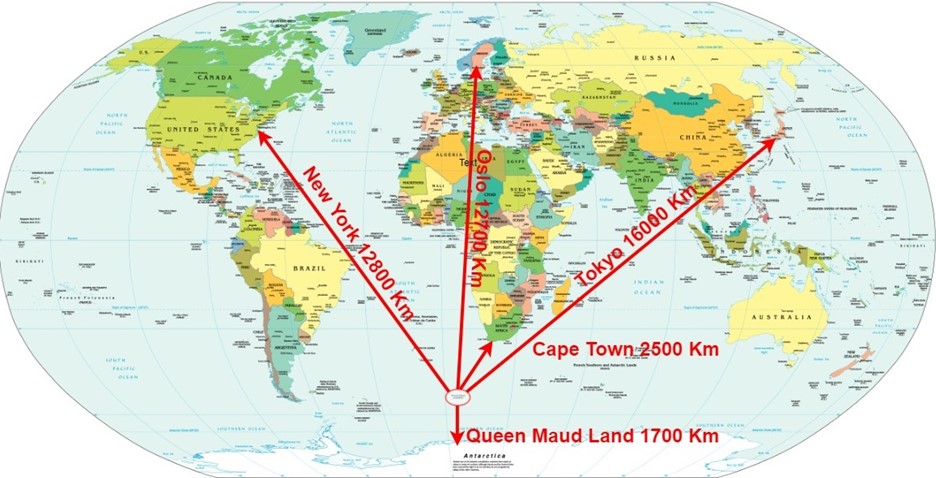
Google Earth map showing distances to Bouvet Island.
3Y0J DXpedition
A group of 12 amateur radio operators led by Ken, LA7GIA; Rune, LA7THA; and Erwann, LB1QI are planning to start the journey to Bouvet Island on January 14, 2023 with the goal to stay and operate on the island for a period of about 22 days and make more than 200,000 QSOs.
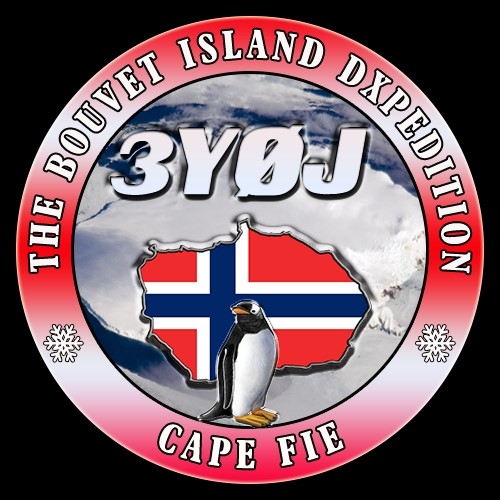
Bouvet Island is like no other DX entity; it is like the Mount Everest of the DX entities. No other DX entity comes even close to the difficulty of a Bouvet activation. No wonder it is positioned at #2 on the DXCC Most Wanted List, right after P5 (North Korea). Indeed, the co-leaders of 3Y0J, apart from their extensive DXpeditioning experience, have a few aces up their sleeve to ensure success and achieve their formidable goal.
The 2,500 Km (1,553 mile) journey to and from Bouvet, from the starting point of Port Stanley in the Falkland Islands to 54° south latitude where Bouvet Island is located, means a journey totaling 45 days of sailing in one of the most frigid and whirling waters of the South Atlantic Ocean. To reach the island the team will be passing the area of the 40° latitude as well as the 50° latitude rightfully nicknamed “The Roaring Forties” and “The Furious Fifties” respectively. And so, the team has chartered the services of the Marama sailing vessel and its crew.
The Boat
Marama is a 101-foot-long Oceanic Ketch, a sailing vessel with an aluminum hull, designed and built in France. Marama is an extremely robust expedition yacht capable of any type of navigation. Secondly and equally important, Marama’s crew is a critical asset for the DXpedition team. The skipper (who is also the owner) of Marama has been doing cold-weather sailing expeditions for the past 12 years in the Northwest Passage, the Arctic, South Georgia, and Antarctica.
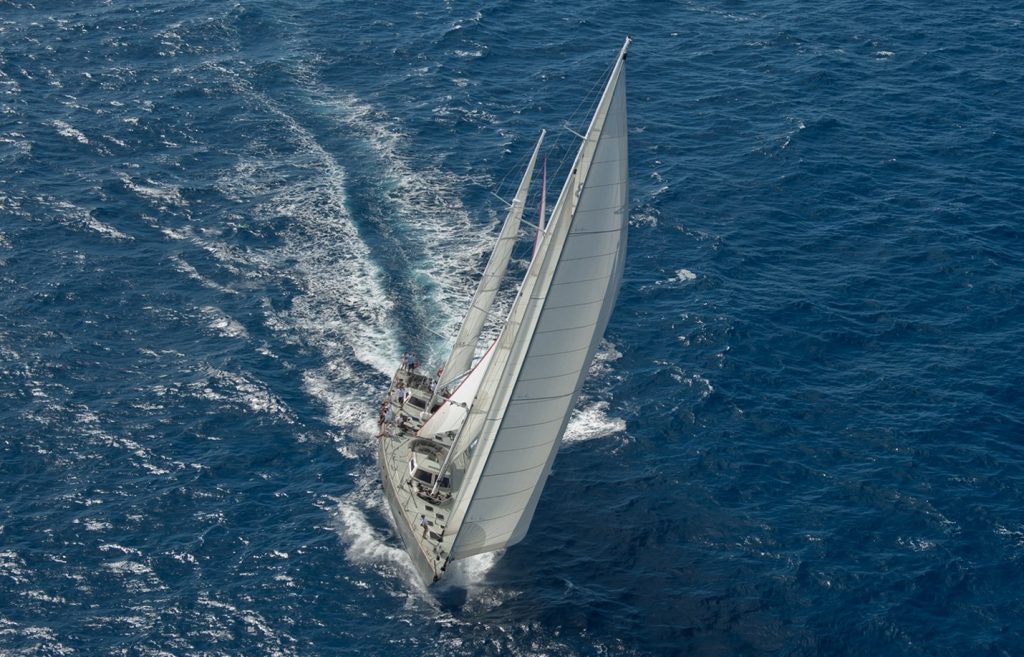
The Marama Oceanic Ketch
There will be no helicopters involved in landing on the island. Although helicopters would be more convenient, they are unfortunately heavily weather-dependent and could be prevented from flying by the clouds and dense fog which often form above Bouvet. Waiting for good weather to land a helicopter is not a good approach, considering that there is an average number of 300 storms a year on Bouvet Island. People have landed on Bouvet by boat for hundreds of years, and with careful planning and preparations our team plans to do just that.
The plan is to land on the island, set up the camp, and stay on the island for about 22 days. Due to the difficulty of landing, the radio team will not leave the island until the end of the DXpedition. Aboard the vessel, the Marama crew will prepare hot meals for the radio team and, weather permitting, attempt to deliver the food to the island. But it is estimated that for a good portion of the stay, the Marama crew will not be able to deliver the food due to bad weather. As such, the team will have Meals-Ready-to-Eat (MRE), military-style food, available to be served for most of the stay on the island.
Last, but not least, the team leaders have put together a relatively young team, which in addition to being good operators and experienced DXpeditioners, would be able to cope with the physical challenges that await on Bouvet. Tasks include loading and unloading equipment onto/from the Zodiacs, then carrying the equipment to a higher ground level to avoid the marine life (i.e., seals and penguins) on the beaches, setting up the camp/tents, and finally setting up the multitude of antennas necessary for the radio operation. All these activities will be happening while coping with our number-one challenge: the weather. The team will be exhausted before even making their first QSO. Physical conditioning is part of the team preparation and strategy before the journey to Bouvet.
Safety
Safety planning started with choosing Marama as the transportation means to get to the island. Its experienced crew members, who have made many previous trips in cold and harsh climates, know exactly what a DXpedition team needs and what is the safest way to achieve that. As a top priority, the DXpedition team leaders have decided to add two doctors (and a dentist, Otis, NP4G) as part of the team, both with extensive emergency medicine experience: Dr. Mike Crownover, AB5EB, and Dr. Bill Straw, KO7SS. There is no hospital or medical facility of any kind available for thousands of miles, and although safety procedures and rules are set in place for the team members to follow, having not one but three medical professionals on the team is a welcome cautionary safety strategy.
There are no perfect anchorage places around Bouvet Island, so during bad weather Marama will have to battle the constant winds with its sails and engines to stay stationary in the vicinity of the island to be ready, at any moment, to ensure the safety of the team. This is also a requirement imposed by the Norwegian Polar Institute (NPI) as a condition of the landing permit approval.
The logistics sub-group is currently analyzing and comparing the different models of polar-grade tents available on the market. In addition to the polar gear (sub-zero parkas) for each team member, a sturdy tent setup that can withstand the harsh weather on Bouvet is a prime step toward a safe environment for the team.
Equipment
Choosing antennas for Bouvet was not a trivial task. The gusts of wind often reach close to 100 miles/hour, and low temperatures pose a serious challenge for antennas and masts. Many off-the-shelf products won’t survive the harsh weather on Bouvet. As such, the antenna sub-group teamed up with InnovAntennas and WiMo, who provided sturdy, easy-to-assemble, high-performance beams for the high bands. These antennas are made of high-quality, strong aluminum.
DX Engineering, a prominent company name in the ham radio world and a supporter of all major DXpeditions, assisted the team in designing, as well as providing, low band TX and RX antennas in addition to other major components.
As for radios, the team decided to use the battletested Elecraft K3S radios that have been chosen by many past successful DXpeditions. The light and performant Expert Amplifiers will be an integral part of the eight SSB/CW stations that the team is planning to set up on the island. The antenna farm and the radio setup will provide the ability to work multiple continents in the same band and at the same time, with multiple beams pointing to multiple continents. During good propagation times, the 12-radio setup (CW/SSB/RTTY/FT8) will provide the ability to work multiple operating modes in the same band and at the same time.
Each piece of equipment (radios, antennas, power supplies, generators, etc.) will have a backup in place to ensure an uninterrupted radio operation in case of equipment failure. This is a first step toward the goal of putting in the log over 200K QSOs. We will operate on the 10M through 160M bands, including 60M in CW, SSB and FT8, but our main focus will be on the “human” modes. There are four FOC members (a CW focused club) on the team: one of the team leaders, Ken, LA7GIA and three additional members, Axel, DL6KVA, Adrian, KO8SCA, and Cezar, VE3LYC. With four FOC members on the team, you can be sure that 3Y0J will enchant many CW enthusiasts around the globe!
There will be no real-time logging because the current Inmarsat satellites barely cover that area of the ocean and, thus, the team’s Internet connection will be slow and unreliable. Depending on the weather, the team is planning to have a daily log upload to ClubLog through an Inmarsat BGAN terminal and give log search capability through the website of 3Y0J QSL manager Charles Wilmott, M0OXO.
There is a new player in the satellite Internet business, a company called StarLink. Their low cost and high Internet speed is amazing, and it will certainly be a welcome tool for DXpeditions to remote places. Although StarLink has announced plans of launching new satellites to cover the area of the ocean where Bouvet Island is located, and the team will have such equipment on the island, we don’t know for sure if the service will be available in January/February 2023.
Preparations
The co-leaders of the DXpedition have been already involved with this project for almost two years, working closely with the Norwegian Polar Institute (NPI) as well as a very experienced off-island team of five Norwegian professionals, and experts, former researchers, and captains. Many of this group have been to Bouvet for several seasons and have stayed anchored at Cape Fie (our landing site, the same landing site used in the past by the first Bouvet DXpedition). They have done Zodiac landings there and are very familiar with the waters around the island. It is the knowledge provided by the NPI and the polar experts that have convinced the team leaders that it is feasible and safe to land on Bouvet at Cape Fie.
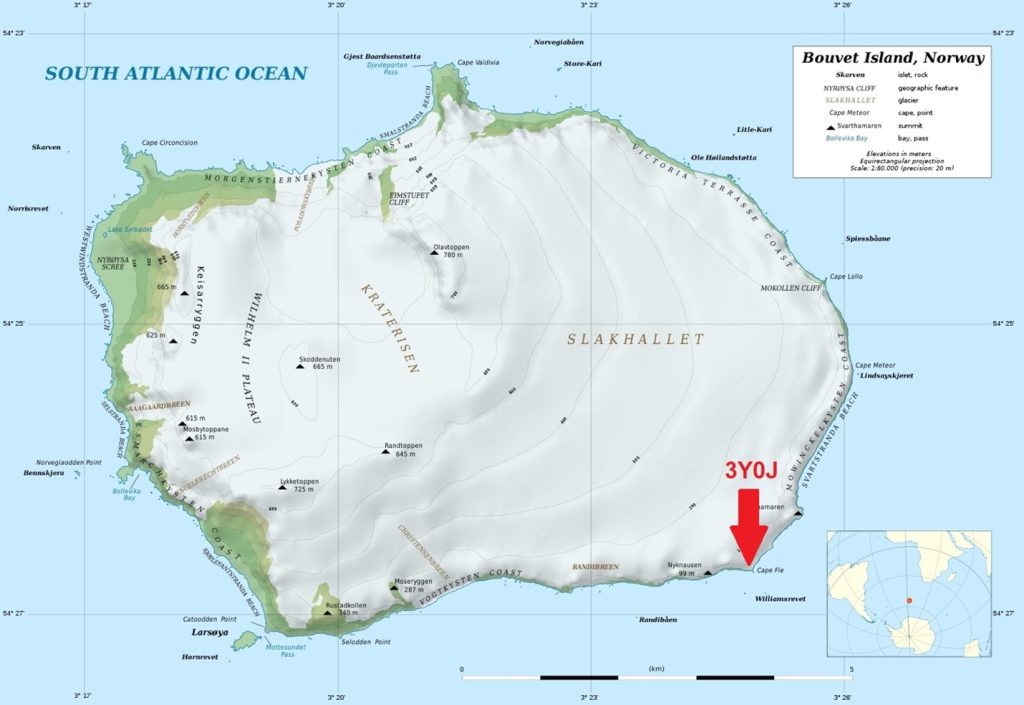
Map showing location of the 3Y0J landing site.
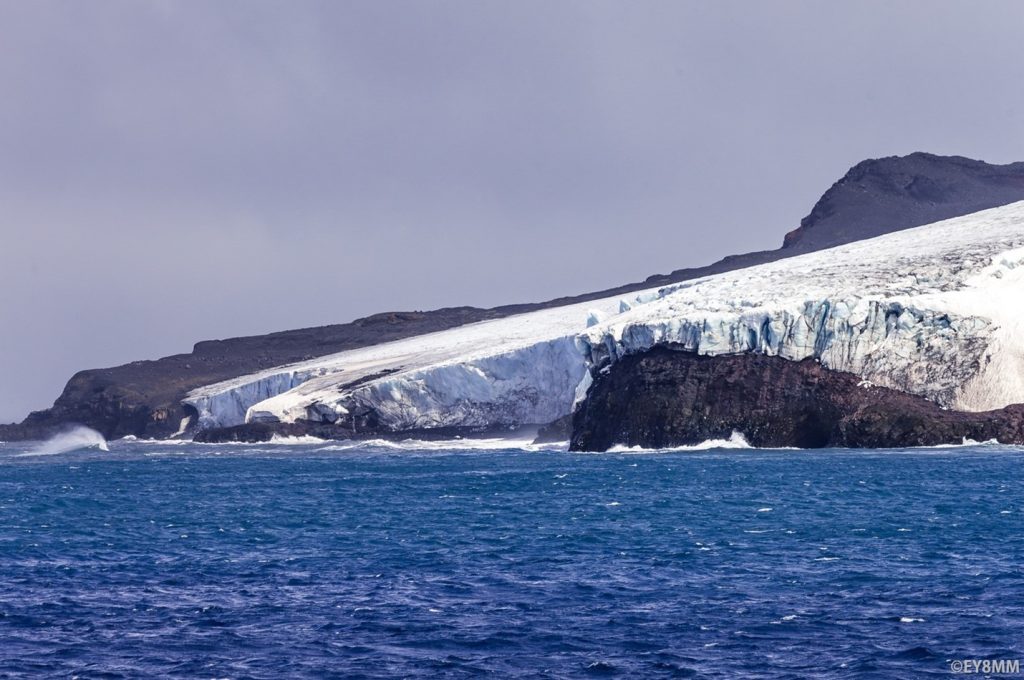
Cape Fie, the landing site of the 3Y0J DXpedition team, photo courtesy of Nodir, EY8MM
The DXpedition is now less than two months away. While this sounds like a lot of time, there is much to prepare. Bouvet Island is like no other DX entity: it is hard to reach, hard to operate from, and expensive to get to. The team must prepare to make sure everything works smoothly like clockwork.
Currently the international 3Y0J team is staying in constant contact through a chatting platform, and video meetings take place often on the Zoom platform. Each team member has a unique set of skills and is able to contribute to the design and implementation of the intricate logistics that need to take place in order to get such a complex project off the ground.
A multitude of meetings also take place between equipment vendors/sponsors and the team to ensure that even the finest details are understood and implemented properly. During the spring of 2022, a good portion of the 3Y0J team gathered at a staging ground in Norway (LN8W superstation, south of Oslo) where each and every piece of equipment was assembled, tested, labeled, and packed in a container that left Oslo in September for its long journey by sea to the Falkland Islands. The equipment container arrived in the Falkland Islands in November.
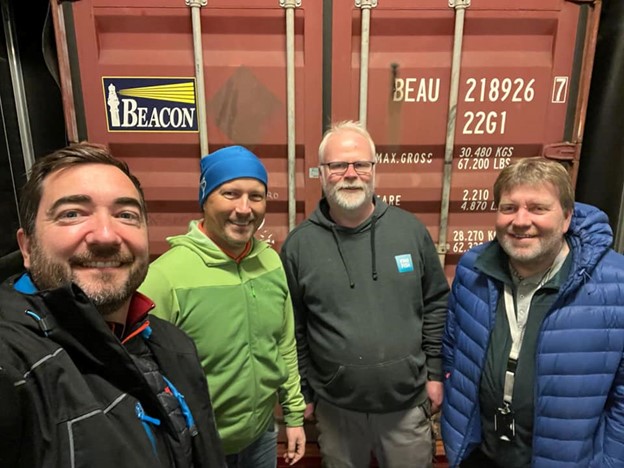
Equipment container ready for its trip from Oslo to the Falkland Islands.
This approach ensures that all equipment will be easily reassembled on Bouvet, with minimum effort, in the correct sequence, and in the most efficient way. This method follows proven techniques used during previous DXpeditions. On November 11-13, members of the 3Y0J team completed an ice climbing course in Norway on the Jostedal Glacier, the largest glacier in continental Europe. These skills will be useful for a backup plan for setting up camp on Bouvet Island.
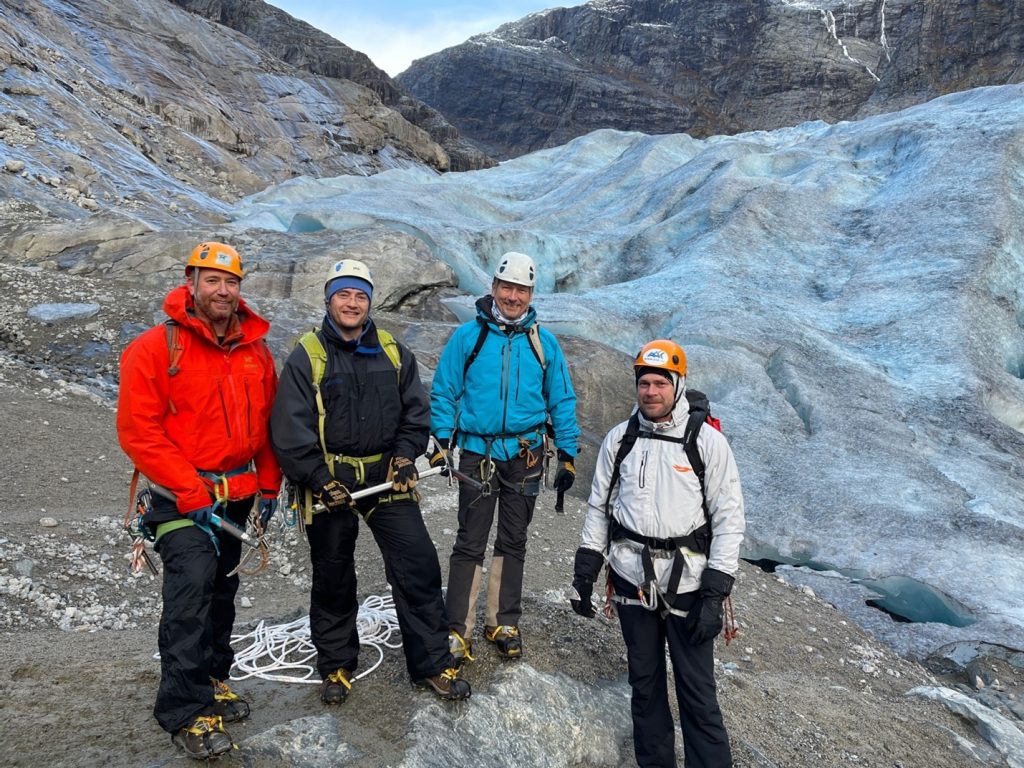
In November 2022, members of the 3Y0J team completed an ice climbing course in Norway.
Past Activations
Bouvet Island has been activated multiple times over the years by Norwegian NPI scientists, weather station operators, and technicians visiting the station for repairs and maintenance, such as John Snuggerud LA1VC (SK), an NPI Scientist who activated Bouvet twice.
But the majority of these past activations have generated few QSOs. The only DXpedition to have ever activated Bouvet in the past was 3Y5X in 1989, when the five operators (LA1EE, LA2GV, JF1IST, F2CW, HB9AHL) made 47K QSOs in 16 days. In addition, Charles Brady N4BQW (SK), a Navy captain and NASA astronaut, managed to make 8K QSOs, mostly SSB, during his two-month stay on the island as 3Y0C. For their service to the ham radio community, both John Snuggerud and Charles Brady are Honorary Team Members of the 3Y0J DXpedition.
It is now easy to see why this entity is so rare. With a promise of making more than 200K QSOs, 3Y0J will be able to satisfy a significant portion of the worldwide demand for this entity. In addition, considering that we are in the upper trend of the current solar Cycle 25, propagation will improve significantly by the time the team arrives on the island and, thus, this goal is certainly doable.
Budget
The DXpedition team leaders have put together a budget of $705K in U.S. dollars. This is a steep price tag, and it will make 3Y0J the most expensive DXpedition ever! The vast majority of this budget (more than 80%) will go to the Marama vessel and crew as well as for purchasing the significant amount of (expensive) fuel necessary for a 45-day voyage and stay on the island.
In addition to being away from work and family for over 45 days, each 3Y0J DXpedition member contributed about $25K to the DXpedition budget. The rest of the budget money will come from amateur radio operators, clubs, and foundations around the world. The Northern California DX Foundation (NCDXF) is the single-most important supporter with $100K. Other organizations such as INDEXA and many other foundations, clubs, and individuals around the world have already significantly contributed to our budget.
Please visit our website and Facebook page for more details and to support our DXpedition. We are counting on your support just like you are counting on us to put you in the 3Y0J log! Time and time again, after the 3Y0J DXpedition ends, you can look back and proudly say, “I helped make that happen!”
This DXpedition will certainly be a true adventure and an exhilarating experience for the team. But beyond the staggering views, the experience of seeing the beauty of space, cold, and silence that await the team during the journey and on the island, the 3Y0J team is ready to bring a new one (ATNO) into the logs of as many ham operators around the world as possible.
When people mention Bouvet they speak only with superlatives: the most remote island, the loneliest place on Earth, the island battered by the most extreme weather. Our team’s plan is to add another one: the most QSOs in human modes as possible for the 22 days on the island!
The 3Y0J Bouvet Island DXpedition is coming soon to a radio near you. Are you ready?

